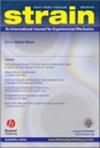利用压痕应力应变分析和有限元模拟确定薄膜的弹塑性能,降低基底的贡献率
IF 2.1
3区 材料科学
Q2 Engineering
引用次数: 0
摘要
保护涂层的机械性能在日常工业环境中至关重要,过渡金属氮化物是最常用的加工工具保护硬涂层之一。然而,由于薄膜/基材系统的反应与厚度有关,因此通过传统方法确定其弹塑性能具有挑战性。在这项研究中,我们利用两层溅射 Ti-Al-N 薄膜作为硬质薄膜/软质基材系统的模型,展示了 Oliver 和 Pharr 方法的替代方法。这种替代方法是通过纳米压痕测试获得的压痕应力-应变曲线来确定杨氏模量、屈服应力和硬度,从而有效降低基底的贡献。在厚度低于 1.0 μm 的薄膜上进行的有限元模拟证实了这种减少。使用我们的方法测定的弹塑性能在典型 Ti-Al-N 薄膜的报告范围内。此外,通过应用我们的方法,我们能够仅根据两种薄膜的微观结构、成分和形态特性,对观察到的机械性能差异进行关联和讨论。因此,我们展示了一种可行的替代方法,可以在使用曲率半径较大(约 650 nm)的压头时,解决薄膜/基底系统机械表征中基底贡献的难题。这项研究对设计具有工业应用价值的亚微米保护膜具有潜在的意义。本文章由计算机程序翻译,如有差异,请以英文原文为准。
Indentation stress–strain analysis and finite element simulation to determine elastoplastic properties of thin films decreasing the substrate contribution
The mechanical performance of protective coatings is crucial in daily industrial environments, with transition metal nitrides being among the most commonly used hard coatings for machining tool protection. However, determining their elastoplastic properties via conventional methods can be challenging due to the thickness‐dependent response of film/substrate systems. In this study, we utilised two sputtering Ti‐Al‐N films as a model hard thin film/soft substrate system to showcase an alternative methodology to the Oliver and Pharr method. This alternative approach involves determining Young's modulus, yield stress and hardness through indentation stress–strain curves obtained from nanoindentation tests, effectively decreasing the substrate's contribution. This decrease was corroborated by finite element simulations conducted on films with thickness below 1.0 μm. The elastoplastic properties determined using our methodology fell within the range reported for typical Ti‐Al‐N films. Furthermore, by applying our methodology, we were able to correlate and discuss the observed differences in mechanical behaviour between the two films based solely on their microstructural, compositional and morphological properties. Thus, we have demonstrated a viable alternative methodology to address substrate contribution challenges in the mechanical characterisation of thin film/substrate systems when employing an indenter with a large radius of curvature (~650 nm). This research holds potential implications for the design of protective submicrometric films with industrial applications.
求助全文
通过发布文献求助,成功后即可免费获取论文全文。
去求助
来源期刊

Strain
MATERIALS SCIENCE, CHARACTERIZATION & TESTING-
CiteScore
4.50
自引率
4.80%
发文量
27
审稿时长
2.3 months
期刊介绍:
Strain is an international journal that contains contributions from leading-edge research on the measurement of the mechanical behaviour of structures and systems. Strain only accepts contributions with sufficient novelty in the design, implementation, and/or validation of experimental methodologies to characterize materials, structures, and systems; i.e. contributions that are limited to the application of established methodologies are outside of the scope of the journal. The journal includes papers from all engineering disciplines that deal with material behaviour and degradation under load, structural design and measurement techniques. Although the thrust of the journal is experimental, numerical simulations and validation are included in the coverage.
Strain welcomes papers that deal with novel work in the following areas:
experimental techniques
non-destructive evaluation techniques
numerical analysis, simulation and validation
residual stress measurement techniques
design of composite structures and components
impact behaviour of materials and structures
signal and image processing
transducer and sensor design
structural health monitoring
biomechanics
extreme environment
micro- and nano-scale testing method.
 求助内容:
求助内容: 应助结果提醒方式:
应助结果提醒方式:


